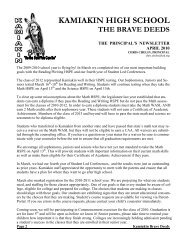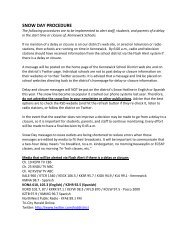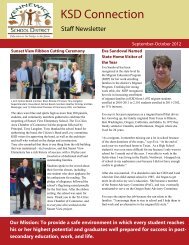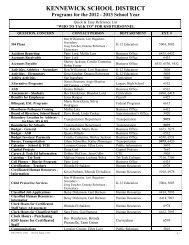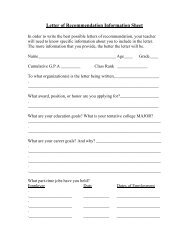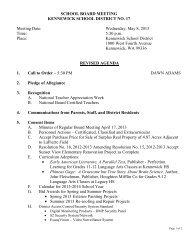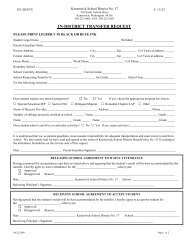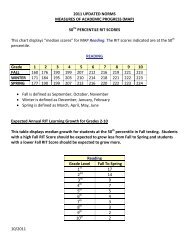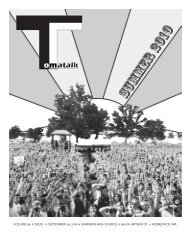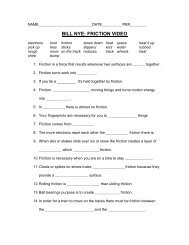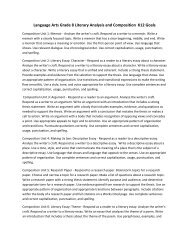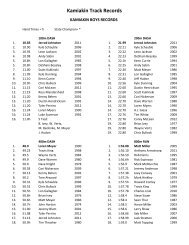Thermodynamics Notes
Thermodynamics Notes
Thermodynamics Notes
Create successful ePaper yourself
Turn your PDF publications into a flip-book with our unique Google optimized e-Paper software.
Temperature, Heat, Kinetic Theory, and <strong>Thermodynamics</strong><br />
Objectives<br />
Students should understand the “mechanical equivalent of heat” so they can determine how much heat<br />
can be produced by the performance of a specified quantity of mechanical work.<br />
Students should understand heat transfer and thermal expansion, so they can:<br />
o Calculate how the flow of heat through a slab of material is affected by changes in the thickness or<br />
area of the slab, or the temperature difference between the two faces of the slab.<br />
o Analyze what happens to the size and shape of an object when it is heated.<br />
o Analyze qualitatively the effects of conduction, radiation and convection in thermal processes.<br />
Students should understand the kinetic theory model of an ideal gas, so they can:<br />
o State the assumptions of the model.<br />
o State the connection between temperature and mean translational kinetic energy, and apply it to<br />
determine the mean speed of gas molecules as a function of their mass and the temperature of<br />
the gas.<br />
o State the relationship among Avogadro’s number, Boltzmann’s constant, and the gas constant R,<br />
and express the energy of a mole of a monatomic ideal gas as a function of its temperature.<br />
o Explain qualitatively how the model explains the pressure of a gas in terms of collisions with the<br />
container walls, and explain how the model predicts that, for fixed volume, pressure must be<br />
proportional to temperature.<br />
Students should know how to apply the ideal gas law and thermodynamic principles, so they can:<br />
o Relate the pressure and volume of a gas during an isothermal expansion or compression.<br />
o Relate the pressure and temperature of a gas during constant-volume heating or cooling, or the<br />
volume and temperature during constant-pressure heating or cooling.<br />
o Calculate the work performed on or by a gas during an expansion or compression at constant<br />
pressure.<br />
o Understand the process of adiabatic expansion or compression of a gas.<br />
o Identify or sketch on a PV diagram the curves that represent each of the above processes.<br />
Students should know how to apply the first law of thermodynamics, so they can:<br />
o Relate the heat absorbed by a gas, the work performed by the gas and the internal energy change<br />
of the gas for any of the processes above.<br />
o Relate the work performed by a gas in a cyclic process to the area enclosed by a curve on a PV<br />
diagram.<br />
Students should understand the second law of thermodynamics, the concept of entropy, and heat engines<br />
and the Carnot cycle, so they can:<br />
o Determine whether entropy will increase, decrease or remain the same during a particular<br />
situation.<br />
o Compute the maximum possible efficiency of a heat engine operating between two given<br />
temperatures.<br />
o Compute the actual efficiency of a heat engine.<br />
o Relate the heats exchanged at each thermal reservoir in a Carnot cycle to the temperatures of the<br />
reservoirs.<br />
13-1: Atomic Theory of Matter<br />
Atomic and molecular masses are measured in unified atomic mass units (u). This unit is defined so that<br />
the carbon-12 atom has a mass of exactly 12.0000 u. Expressed in kilograms: ________________________<br />
________________________________ describes the continuous random motion of the<br />
atoms in all matter due to a series of collisions.<br />
On a microscopic scale, the arrangements of molecules in ____________ (a),<br />
______________ (b), and _________ (c) are quite different.
13-2: Temperature and Thermometers<br />
________________________ is a measure of how hot or cold something is.<br />
Most materials ____________ when ______________.<br />
Scales for measuring temperature include Celsius (centigrade), Fahrenheit, and Kelvin. The<br />
standard conversion from Fahrenheit to Celsius is<br />
; this can be<br />
rearranged to convert from Celsius to Fahrenheit as<br />
<br />
Example 13-2: Taking your temperature<br />
Normal body temperature is 98.6°F. What is this on the Celsius scale?<br />
Exercise A<br />
Determine the temperature at which both sides agree (T C = T F )<br />
13-3: Thermal Equilibrium and the Zeroth Law of <strong>Thermodynamics</strong><br />
Two objects placed in thermal contact will eventually come to the same temperature. When they do, we<br />
say they are in ____________________________________.<br />
The _____________________ of thermodynamics says that if two objects are each in equilibrium with a<br />
third object, they are also in thermal equilibrium with each other.<br />
13-4: Thermal Expansion<br />
__________________ changes can yield changes in the ____________ and ______________ of an object.<br />
The change in length is a function of the change in temperature;<br />
o represents the ______________________________________________________ for a material.<br />
o is in ______<br />
o Additionally, the new length of the object can be represented by the equation<br />
<br />
<br />
Volume expansion is similar, except that it is relevant for liquids and gases as well as solids.<br />
The change in volume is a function of the change in temperature;<br />
o represents the ______________________________________________________ for a material.<br />
o is in ______<br />
o Additionally, the new volume of the object can be represented by the equation
Example 13-3: Bridge expansion<br />
The steel bed of a suspension bridge is 200 m long at 20°C. If the extremes of temperature to which it might be<br />
exposed to are -30°C to +40°C, how much will it contract and expand?<br />
Conceptual Example 13-4: Do holes expand or contract?<br />
If you heat a thin circular ring in the oven, does the ring’s hole get larger or smaller?<br />
Example 13-5: Ring on a rod<br />
An iron ring is to fit snugly on a cylindrical iron rod. At 20°C, the diameter of the rod is 6.445 cm and the inside<br />
diameter of the ring is 6.420 cm. To slip over the rod, the ring must be slightly larger than the rod diameter by<br />
about 0.008 cm. To what temperature must the ring be brought if its hole is to be large enough so it will slip<br />
over the rod?<br />
Conceptual Example 13-6: Opening a tight jar lid<br />
When the lid of a glass jar is tight, holding the lid under hot water for a short time will often make it easier to<br />
open. Why?<br />
Example 13-7: Gas tank in the sun<br />
The 70-L steel gas tank of a car is filled to the top with gasoline at 20°C. The car sits in the sun and the tank<br />
reaches a temperature of 40°C (104°F). How much gasoline do you expect to overflow from the tank?<br />
13-6: The Gas Laws and Absolute Temperature<br />
_________________, _______________, and ________________________ are interrelated for gases.<br />
_______________: At a constant temperature, volume is inversely proportional to pressure.<br />
_______________: At a constant pressure, volume is directly proportional to absolute temperature.<br />
____________________: At a constant volume, pressure is directly proportional to absolute temperature.<br />
13-6: The Gas Laws and Absolute Temperature<br />
Extrapolating, the volume becomes zero at −273.15°C; this temperature is called ____________________.<br />
The concept of absolute zero allows us to define a third temperature scale – the absolute, or Kelvin, scale.<br />
This scale starts with 0 K at absolute zero, but otherwise is the same as the Celsius scale.<br />
The following equation can be used to convert from Celsius to Kelvin____________________________<br />
Conceptual Example 13-9: Don’t throw a closed glass jar into a campfire<br />
What can happen if you did throw an empty glass jar, with lid on tight, into a fire, and why?<br />
13-7: The Ideal Gas Law<br />
The three gas laws are combined in the ideal gas law, , where is the number of<br />
moles of a substance and is the universal gas constant = __________ J/(mol·K) or R = ____________<br />
(L·atm)/(mol·K)
A mole (mol) is defined as the number of grams of a substance that is numerically equal to the molecular<br />
mass of the substance:<br />
o 1 mol H2 has a mass of 2 g<br />
o 1 mol Ne has a mass of 20 g<br />
o 1 mol CO2 has a mass of 44 g<br />
The number of moles in a certain mass of material:<br />
13-8: Problem Solving with the Ideal Gas Law<br />
Standard temperature and pressure (______)<br />
o T = 273 K<br />
o P = 1.00 atm = 1.013 x 10 5 N/m 2<br />
Always measure T in __________<br />
P must be the __________________________________<br />
Example 13-10: Volume of one mol at STP<br />
Determine the volume of 1.00 mol of any gas assuming it behaves like an ideal gas, at STP.<br />
Exercise B<br />
What is the volume of 1.00 mol of ideal gas at 20°C?<br />
Example 13-11: Helium balloon<br />
A helium party balloon, assumed to be a perfect sphere, has a radius of 18.0 cm. At room temperature (20°C),<br />
its internal pressure is 1.05 atm. Find the number of moles of helium in the balloon and the mass of helium<br />
needed to inflate the balloon to these values.<br />
Example 13-12: Estimate mass of air in a room<br />
Estimate the mass of air in a room whose dimensions are 5 m x 3 m x 2.5 m high, at STP.<br />
Exercise C<br />
At 20 °C, would there be more or less air mass in a room than at 0°C?<br />
Example 13-13: Check tires cold<br />
An automobile tire is filled to a gauge pressure of 200 kPa at 10°C. After a drive of 100 km, the temperature<br />
within the tire rises to 40°C. What is the pressure within the tire now?
13-9: Ideal Gas Law in Terms of Molecules: Avogadro’s Number<br />
Since the gas constant is universal, the number of molecules in one mole is the same for all gases. That<br />
number is called Avogadro’s number:<br />
The number of molecules in a gas is the number of moles times Avogadro’s number:<br />
This allows for a restatement of the ideal gas law with Avogadro’s number as _____________, where k is<br />
referred to as Boltzmann’s constant.<br />
Example 13-14: Hydrogen atom mass<br />
Use Avogadro’s number to determine the mass of a hydrogen atom.<br />
Example 13-15: Estimate how many molecules are in one breath<br />
Estimate how many molecules you breathe in with a 1.0-L breath of air.<br />
13-10: Kinetic Theory and the Molecular Interpretation of Temperature<br />
Assumptions of ____________________:<br />
o Large number of molecules, moving in random directions with a ___________________________<br />
o Molecules are far apart, on average<br />
o Molecules obey laws of classical mechanics and interact only when colliding<br />
o Collisions are perfectly _____________<br />
Calculating average force using the average momentum of molecules in a gas, we can apply the ideal gas<br />
law to determine the average kinetic energy.<br />
The root-mean-square velocity can be found from<br />
Example 13-6: Molecular kinetic energy<br />
What is the average translational kinetic energy of molecules in an ideal gas at 37°C?<br />
Example 13-17: Speeds of air molecules<br />
What is the rms speed of air molecules (O 2 and N 2 ) at room temperature (20°C)?<br />
Exercise D<br />
What speed would a 1-gram paper clip have if it had the same KE as a molecule of Example 13-17?



